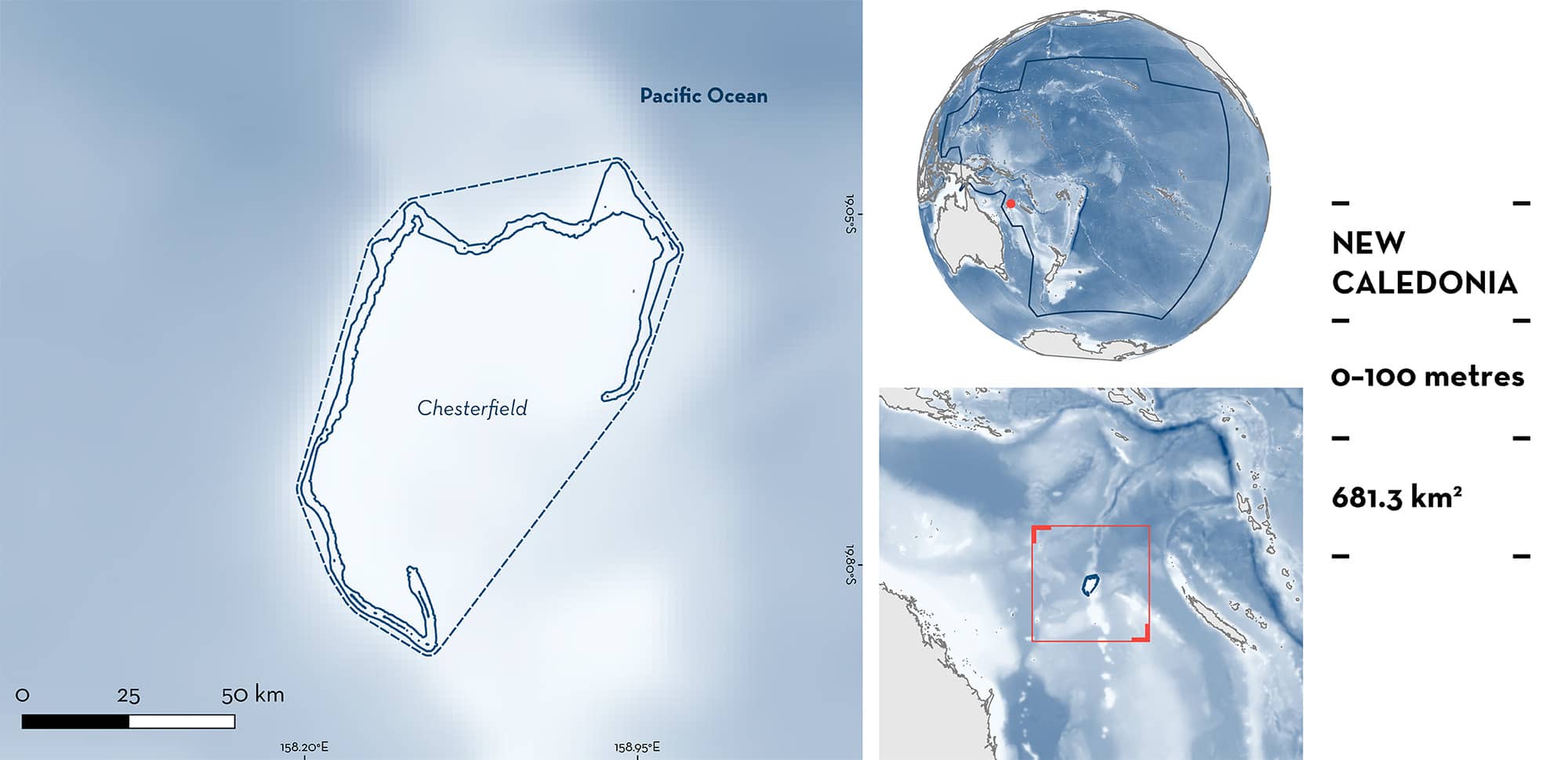ISRA FACTSHEETS
ISRA FACTSHEETS
NEW ZEALAND & PACIFIC ISLANDS REGION
Chesterfield
Summary
Chesterfield is located in New Caledonia. The area is situated ~550 km from Grande Terre Island. The area consists of multiple reefs and includes 11 small islets with multiple keys. It has a barrier reef surrounding a lagoon and is characterised by live coral and sandy substrates. The area overlaps with the Récifs Bampton et Chesterfield marine Key Biodiversity Area and the Natural Park of the Coral Sea. Within the area there are: threatened species and undefined aggregations (Grey Reef Shark Carcharhinus amblyrhynchos).
Download factsheet
Chesterfield
DESCRIPTION OF HABITAT
Chesterfield is located in New Caledonia. It is situated on the eastern side of the exclusive economic zone in a north-south oceanic ridge within the Coral Sea, ~550 km northwest of Grande Terre Island. The area consists of multiple reefs and includes 11 small (<2 km long) islets with multiple keys. It has a barrier reef surrounding a deep lagoon (~50 m) that gets shallower in the southern part (Chevillon & Clavier 1990). The area is open on the eastern side to oceanic waters and the barrier reef has many wide passages (Clua et al. 2015). A large part of the lagoon is influenced by swells and trade winds and by the South Equatorial Current that after passing through the main island contributes to the North Caledonia Jet (Cravatte et al. 2015). Live coral and sand are the most common substrates (Pelletier et al. 2020; Wantiez et al. 2023).
The area overlaps with the Récifs Bampton et Chesterfield marine Key Biodiversity Area (KBA 2024) and the Natural Park of the Coral Sea (UNEP-WCMC & IUCN 2024).
This Important Shark and Ray Area is benthic and pelagic and is delineated from inshore and surface waters (0 m) to 100 m based on the bathymetry of the area.
CRITERION A
VULNERABILITY
One Qualifying Species considered threatened with extinction according to the IUCN Red List of Threatened Species regularly occur in the area. This is the Endangered Grey Reef Shark (Simpfendorfer et al. 2020).
CRITERION C
SUB-CRITERION C5 – UNDEFINED AGGREGATIONS
Chesterfield is an important area for undefined aggregations of one shark species.
Anecdotal observations from the 1970s and 1980s reported aggregations of ~100 Grey Reef Sharks in the area (Clua et al. 2011). Further, in 2010 visual surveys (n = 8) were conducted and 50 Grey Reef Sharks were observed in the area with eight aggregations between 3–15 individuals between 90–160 cm total length (TL) observed (Clua et al. 2011). Contemporary information indicates that aggregations of Grey Reef Sharks are still regularly observed in this area and have been documented by underwater surveys, visual censuses, and Baited Remote Underwater Video Station (BRUVS) surveys (Clua et al. 2011; Vigliola et al. 2014; Clua & Vignaud 2016; Juhel et al. 2017; Bonnin et al. 2021, 2023; Boussarie et al. 2022; Walsh et al. 2022; Wantiez et al. 2023).
Between 2012–2014, underwater surveys (n = 253) were conducted along all New Caledonia reefs. Surveys consisted of fixed-width transects (25 m long by 4 m wide at 10 and 20 m depths), distance-sampling visual census (50 m long by 10 m wide at ~15 m depth) and BRUVS (1 hour at ~20 m depth; Vigliola et al. 2014). Of these surveys, 64 were conducted in Chesterfield during 2013 and 2014, showing that Grey Reef Sharks aggregate in the area (Vigliola et al. 2014). Grey Reef Sharks were observed in 87% of the visual census and in BRUVS MaxN values (MaxN = 7; calculated as the maximum number of individuals of a species observed in a single frame) were the second largest in all New Caledonia. In addition, surveys with BRUVS (2012–2014) and distance-sampling visual census (2012–2014) were conducted at 385 sites for BRUVS and 2,790 sits for visual census (including 15 marine protected area) along New Caledonia with Chesterfield holding one of the largest abundances for sharks among all sites (Juhel et al. 2017). Aggregations for Grey Reef Sharks in visual censuses (mean = four individuals, maximum = 10 individuals) and BRUVS (mean = four individuals, maximum = seven individuals) were among the largest in all New Caledonia and were found all around the area (Juhel et al. 2017). In November 2022, 21 fixed-width transect surveys were conducted in the area and 26 sharks were counted (Wantiez et al. 2023). Of these sharks, 19 were Grey Reef Sharks measuring 100–170 cm TL (Wantiez et al. 2023). Grey Reef Sharks were observed in forereefs and in 38.1% of the stations sampled (Wantiez et al. 2023). More information is needed to understand the nature and function of these aggregations.
Download factsheet
SUBMIT A REQUEST
ISRA SPATIAL LAYER REQUEST
To make a request to download the ISRA Layer in either a GIS compatible Shapefile (.shp) or Google Earth compatible Keyhole Markup Language Zipped file (.kmz) please complete the following form. We will review your request and send the download details to you. We will endeavor to send you the requested files as soon as we can. However, please note that this is not an automated process, and before requests are responded to, they undergo internal review and authorization. As such, requests normally take 5–10 working days to process.
Should you have questions about the data or process, please do not hesitate to contact us.


